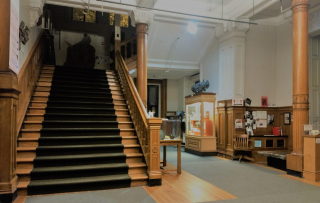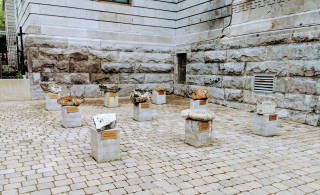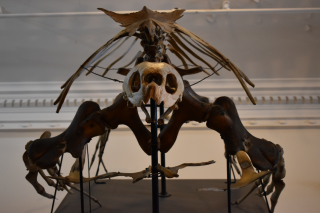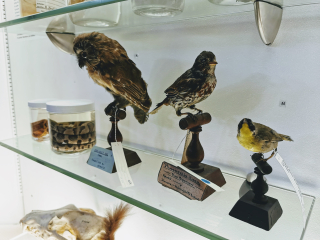
 Entrance
Entrance
Our Entrance Hall is your gateway to discovering the wonders of the Redpath museum. Built over 135 years ago, inside its walls are a story of nature, culture and history to be discovered. Take a moment to appreciate the architecture and beauty of its Victorian design and let yourself be immersed in the wonders of the natural and cultural world we call home.
 Mineralogy Garden
Mineralogy Garden
The geological garden contains many samples of minerals and fossils from various parts of Quebec and Canada, that emphasize the unique and diverse geological history of the region. Among the specimens, are a large fossilized ammonite (ancient cephalopod), minerals commonly mined from vein-dykes in the Montreal area, and a slab of the famous Eozoon canadensis; a pseudfossil first found in 1858, in the Grenville limestone near Côte St. Pierre, QC. See it during the spring, summer and fall seasons.
What to look for on this floor?
Back to the sea
 Come witness the diversity of life and the powerful force of evolution, as this exhibit features prehistoric and living animals that have transitioned from water to land and back to water again, over millions of years on earth. See some of the largest, most ancient and intriguing life in our oceans, including extinct species of pliosaurs and ichthyosaurs, extant species of whales, walrus and other mammals, as well as reptiles, such as sea turtles and more!
Come witness the diversity of life and the powerful force of evolution, as this exhibit features prehistoric and living animals that have transitioned from water to land and back to water again, over millions of years on earth. See some of the largest, most ancient and intriguing life in our oceans, including extinct species of pliosaurs and ichthyosaurs, extant species of whales, walrus and other mammals, as well as reptiles, such as sea turtles and more!
Auditorium exhibit
 The Redpath Museum's historic auditorium has accommodated many McGill classes and lectures for over a century of academic learning. It is also a very popular venue for many other academic presentations, guest lectures, science and cultural conferences, as well as mainstream media and arts projects. The lecture hall also contains four exhibit cases, which have recently been renovated to display a new exhibit entitled the Four Pillars of the Redpath Museum. Each of the four display cases contains a selection of artefacts and specimens that represent the history and diversity of the Redpath Museum's collections. These four cases present the museum's Biodiversity, Mineralogy, Palaeontology and World Cultures collections. The display was designed and installed by Lauren McAusland, a McGill undergraduate student, with the assistance of museum curatorial staff, Anthony Howell (Natural History collections manager/zoology technician), Annie Lussier (World Cultures curator), and Ingrid Birker (Public Outreach Manager).
The Redpath Museum's historic auditorium has accommodated many McGill classes and lectures for over a century of academic learning. It is also a very popular venue for many other academic presentations, guest lectures, science and cultural conferences, as well as mainstream media and arts projects. The lecture hall also contains four exhibit cases, which have recently been renovated to display a new exhibit entitled the Four Pillars of the Redpath Museum. Each of the four display cases contains a selection of artefacts and specimens that represent the history and diversity of the Redpath Museum's collections. These four cases present the museum's Biodiversity, Mineralogy, Palaeontology and World Cultures collections. The display was designed and installed by Lauren McAusland, a McGill undergraduate student, with the assistance of museum curatorial staff, Anthony Howell (Natural History collections manager/zoology technician), Annie Lussier (World Cultures curator), and Ingrid Birker (Public Outreach Manager).
View Lauren's project in the Four Pillars of the Redpath Museum section.
Japanese sea crab
 Toting the distinguished title of world’s largest crab, with a leg span of nearly 12 feet wide, the Japanese Spider Crab (Macrocheira kaempferi) is a sight to be seen. Living in the deep waters of the north Pacific Ocean and potentially living up to 100 years, this colossal marine arthropod feeds on everything from shellfish and dead animals, to plants, algae and mollusks. They are a critical member of the food chain, acting as both ocean decomposer (eating dead animals) and secondary consumers (hunting other animals). Come experience and marvel at a true wonder of the deep ocean with this main floor exhibit.
Toting the distinguished title of world’s largest crab, with a leg span of nearly 12 feet wide, the Japanese Spider Crab (Macrocheira kaempferi) is a sight to be seen. Living in the deep waters of the north Pacific Ocean and potentially living up to 100 years, this colossal marine arthropod feeds on everything from shellfish and dead animals, to plants, algae and mollusks. They are a critical member of the food chain, acting as both ocean decomposer (eating dead animals) and secondary consumers (hunting other animals). Come experience and marvel at a true wonder of the deep ocean with this main floor exhibit.
Curiosity Cabinet
